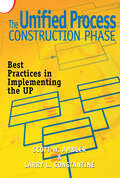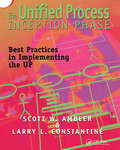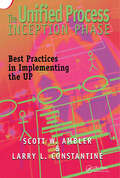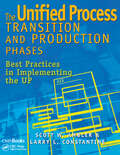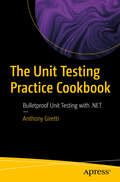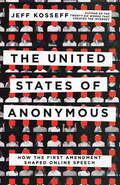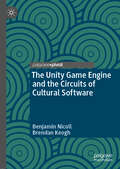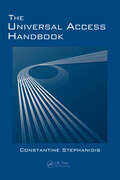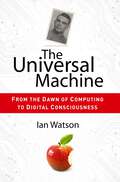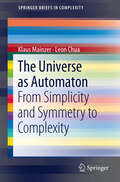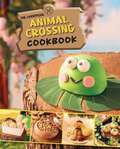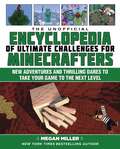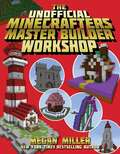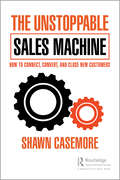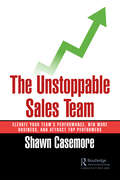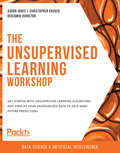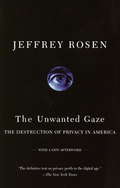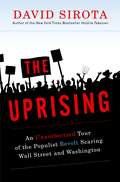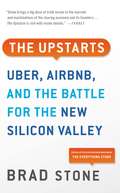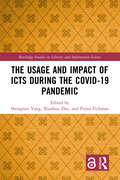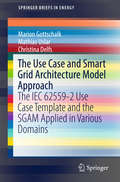- Table View
- List View
The Unified Process Construction Phase: Best Practices in Implementing the UP
by Scott AmblerIs the Unified Process the be all and end all standard for developing object-oriented component-based software? This book focuses on the design and implementation skeletal versions of systems for purposes of testing early in the life cycle for quality control.
The Unified Process Elaboration Phase: Best Practices in Implementing the UP
by Scott AmblerIs the Unified Process the be all and end all standard for developing object-oriented component-based software? Scott Ambler doesn't think so. This book is one in a four-volume series that presents a critical review of the Unified Process -- designed to p
The Unified Process Inception Phase: Best Practices in Implementing the UP
by Larry Constantine Scott W. AmblerIs the Unified Process the be all and end all standard for developing object-oriented component-based software? This book is the third in a four volume series that presents a critical review of the Unified Process. The authors present a survey of the alte
The Unified Process Transition and Production Phases: Best Practices in Implementing the UP
by Scott W. Ambler Larry ConstantineIs the Unified Process the be all and end all standard for developing object-oriented component-based software? This book is the final in a four volume series that presents a critical review of the Unified Process. The authors present a survey of the alte
The Unilateral Presidency and the News Media
by Mark MajorMedia coverage of presidential actions can not only serve journalistic purposes, but can also act as a check against unilateral decision making. The book seeks to uncover how the news media has worked to curtail overreaching power within the executive branch, demonstrating how the fourth estate keeps presidential overreach at bay.
The Unit Testing Practice Cookbook: Bulletproof Unit Testing with .NET
by Anthony GirettiMaster unit testing with the .NET framework by observing examples of best practices. After reading this book, you will feel confident and prepared to approach most situations that a developer will encounter on .NET and ASP.NET Core applications. Learn the best tools to practice effective unit testing, how to architect your code so that it is easily testable, and improve your code coverage. This book is packed with concrete case studies selected from the real-world experiences of a veteran developer, especially when it comes to legacy code. After reading The Unit Testing Practice Cookbook, you will be able to approach unit testing with confidence and make your .NET applications as reliable as possible. What You Will Learn Master unit testing practice Architect your applications efficiently to make your code easily testable Use the best tools for unit testing Automate your unit tests Who This Book is For This book is intended for any developer level wishing to master unit tests with the Microsoft .NET Framework.
The United States of Anonymous: How the First Amendment Shaped Online Speech
by Jeff KosseffIn The United States of Anonymous, Jeff Kosseff explores how the right to anonymity has shaped American values, politics, business, security, and discourse, particularly as technology has enabled people to separate their identities from their communications. Legal and political debates surrounding online privacy often focus on the Fourth Amendment's protection against unreasonable searches and seizures, overlooking the history and future of an equally powerful privacy right: the First Amendment's protection of anonymity. The United States of Anonymous features extensive and engaging interviews with people involved in the highest profile anonymity cases, as well as with those who have benefited from, and been harmed by, anonymous communications. Through these interviews, Kosseff explores how courts have protected anonymity for decades and, likewise, how law and technology have allowed individuals to control how much, if any, identifying information is associated with their communications. From blocking laws that prevent Ku Klux Klan members from wearing masks to restraining Alabama officials from forcing the NAACP to disclose its membership lists, and to refusing companies' requests to unmask online critics, courts have recognized that anonymity is a vital part of our free speech protections. The United States of Anonymous weighs the tradeoffs between the right to hide identity and the harms of anonymity, concluding that we must maintain a strong, if not absolute, right to anonymous speech.
The Unity Game Engine and the Circuits of Cultural Software
by Benjamin Nicoll Brendan KeoghVideogames were once made with a vast range of tools and technologies, but in recent years a small number of commercially available 'game engines' have reached an unprecedented level of dominance in the global videogame industry. In particular, the Unity game engine has penetrated all scales of videogame development, from the large studio to the hobbyist bedroom, such that over half of all new videogames are reportedly being made with Unity. This book provides an urgently needed critical analysis of Unity as ‘cultural software’ that facilitates particular production workflows, design methodologies, and software literacies. Building on long-standing methods in media and cultural studies, and drawing on interviews with a range of videogame developers, Benjamin Nicoll and Brendan Keogh argue that Unity deploys a discourse of democratization to draw users into its ‘circuits of cultural software’. For scholars of media production, software culture, and platform studies, this book provides a framework and language to better articulate the increasingly dominant role of software tools in cultural production. For videogame developers, educators, and students, it provides critical and historical grounding for a tool that is widely used yet rarely analysed from a cultural angle.
The Universal Access Handbook (Human Factors and Ergonomics)
by Constantine StephanidisIn recent years, the field of Universal Access has made significant progress in consolidating theoretical approaches, scientific methods and technologies, as well as in exploring new application domains. Increasingly, professionals in this rapidly maturing area require a comprehensive and multidisciplinary resource that addresses current principles
The Universal Machine
by Ian WatsonThe computer unlike other inventions is universal; you can use a computer for many tasks: writing, composing music, designing buildings, creating movies, inhabiting virtual worlds, communicating... This popular science history isn't just about technology but introduces the pioneers: Babbage, Turing, Apple's Wozniak and Jobs, Bill Gates, Tim Berners-Lee, Mark Zuckerberg. This story is about people and the changes computers have caused. In the future ubiquitous computing, AI, quantum and molecular computing could even make us immortal. The computer has been a radical invention. In less than a single human life computers are transforming economies and societies like no human invention before.
The Universe as Automaton
by Klaus Mainzer Leon ChuaThis Brief is an essay at the interface of philosophy and complexity research, trying to inspire the reader with new ideas and new conceptual developments of cellular automata. Going beyond the numerical experiments of Steven Wolfram, it is argued that cellular automata must be considered complex dynamical systems in their own right, requiring appropriate analytical models in order to find precise answers and predictions in the universe of cellular automata. Indeed, eventually we have to ask whether cellular automata can be considered models of the real world and, conversely, whether there are limits to our modern approach of attributing the world, and the universe for that matter, essentially a digital reality.
The Unknown Component Problem
by Alberto Sangiovanni-Vincentelli Alan Mishchenko Alexandre Petrenko Tiziano Villa Robert K. Brayton Nina YevtushenkoThe Problem of the Unknown Component: Theory and Applications addresses the issue of designing a component that, combined with a known part of a system, conforms to an overall specification. The authors tackle this problem by solving abstract equations over a language. The most general solutions are studied when both synchronous and parallel composition operators are used. The abstract equations are specialized to languages associated with important classes of automata used for modeling systems. The book is a blend of theory and practice, which includes a description of a software package with applications to sequential synthesis of finite state machines. Specific topologies interconnecting the components, exact and heuristic techniques, and optimization scenarios are studied. Finally the scope is enlarged to domains like testing, supervisory control, game theory and synthesis for special omega languages. The authors present original results of the authors along with an overview of existing ones.
The Unofficial Animal Crossing Cookbook
by Tom GrimmA Simon & Schuster eBook. Simon & Schuster has a great book for every reader.
The Unofficial Encyclopedia of Ultimate Challenges for Minecrafters: New Adventures and Thrilling Dares to Take Your Game to the Next Level (Encyclopedia For Minecrafters Series)
by Megan MillerThe Minecraft universe is limitless. <P><P>You can explore as far as you like, build neverending castles, and battle hordes of monsters. But once you have your base, farms, weapons, and armor, what’s next? <P><P>When you're tired of the same old moves and you're hungry for new gameplay, The Unofficial Encyclopedia of Ultimate Challenges for Minecrafters will keep you busy with advanced maneuvers, thrilling new adventures, and extreme dares. You're not a true champion Minecrafter until you've . . . <P><P>Collected every mob in your own zoo Played the game King of the Ladder Completed every in-game advancement Defeated the Ender Dragon in hardcore mode Survived Survival Island Bested Ultra Hardcore PVE/PVP competitions And more! With hundreds of screenshots for easy visual reference and definitions of every term that might trip a player up, this exciting book covers the A to Z of exploring the infinite possibilities of Minecraft gameplay.
The Unofficial Minecrafters Master Builder Workshop
by Megan MillerThe Unofficial Minecrafters Master Builder Workshop is the fun and easy starting guide to making your own Minecraft builds! Helping you learn how to make all the cool builds you’ve seen online, this book comes packed with hundreds of step-by-step photos and instructions to make tinkering in your master building workshop simple! Find out all you need to know about tools, strategies, mining, and mobs to get you started on your Minecraft gaming adventure. Perfect for beginner to advanced Minecrafters who want to learn more! Includes hundreds of full-color photos to show every step of the way! Gets you thinking while building a world of fun! Break free from the standard designs and become the master builder you’ve always wanted to be with The Unofficial Minecrafters Master Builder Workshop!
The Unofficial Sims Cookbook: From Baked Alaska to Silly Gummy Bear Pancakes, 85+ Recipes to Satisfy the Hunger Need (Unofficial Cookbook)
by Taylor O’HalloranLearn how to make all the meals you&’ve seen your Sims devour with The Unofficial Sims Cookbook.Sure, you&’ve honed your Sims&’ cooking skills, but how are your skills IRL? Now, you can perfect the baked Alaska and lobster thermidor you&’ve been watching your Sims make with The Unofficial Sims Cookbook. Learn the steps behind the classic simulated recipes: -Chili Con Carne -Silly Gummy Bear Pancakes -Grandma&’s Comfort Soup -Minty Mocha Cupcakes -And more! Your hunger will be satisfied, and you may even start your career path towards becoming a famous chef! Dive straight in with the delicious recipes in The Unofficial Sims Cookbook.
The Unpredictable Certainty: Information Infrastructure Through 2000
by NII 2000 Steering CommitteeWe have available an impressive array of information technology. We can transmit literature, movies, music, and talk. Government, businesses, and individuals are eager to go on-line to buy, sell, teach, learn, and more. How, then, should we go about developing an infrastructure for on- line communication among everyone everywhere? The Unpredictable Certainty explores the national information infrastructure (NII) as the collection of all public and private information services. But how and when will the NII become a reality? How will more and better services reach the home, small businesses, and remote locations? The Unpredictable Certainty examines who will finance the NII, exploring how technology companies decide to invest in deployment and the the vain search for "killer apps" (applications that drive markets). It discusses who will pay for ongoing services and how they will pay, looking at past cost/price models relevant to the future. The Unpredictable Certainty discusses the underlying technologies, appliances, and services needed before the NII becomes a reality; reviews key features of important technologies; and analyzes current levels of deployment in telephone, cable and broadcast television, and wireless systems, and the difficulties in interconnection. The volume explores the challenge of open interfaces that stimulate new applications but also facilitate competition, the trend toward the separation of infrastructure from specific services, the tension between mature services and new contenders, the growth of the Internet, and more. The roles governments at different levels might play in fostering NII deployment are outlined, including R&D and the use of information infrastructure for better delivery of government services and information.
The Unstoppable Sales Machine: How to Connect, Convert, and Close New Customers
by Shawn CasemoreThis book addresses a gap in how organizations adopt and introduce modern sales strategies. It is written for business owners, sales executives, leaders, and professionals -- anyone who has the desire to create a rapid and sustained increase in their sales, without having to invest a significant amount of time or money in doing so. This book, a comprehensive review of the author's work with clients, introduces "Unstoppable Selling" -- it captures the strategies and tactics the author's clients have used to allow them predictability in their sales. All of the powerful models, tools, and resources are contained here, including the Unstoppable Sales Strategic Multiplier, Hybrid Sales Funnel, Velocity Stack, and Customer Empowerment Service Model. In addition, the book demonstrates how you can quickly establish your Unstoppable Sales Machine regardless of the size or sector of your business. Installing your own unstoppable sales machine will not require you to hire a bunch of experts or more employees. This book accepts you where you are and then walks you through the steps to quickly introduce and launch your very own machine. You’ll find all of the advice, guidance, case studies, and worksheets contained in this one convenient book, ready for you to implement. If you intend to scale your business, or you simply want more freedom from the daily rollercoaster of your current sales strategy, then this is the book for you. The author wrote this book because sales is a noble profession and is the heart and soul of every business -- Yet the continued evolution of today’s customers, how they engage, select and buy products and services, requires we rethink how we approach selling. He shows you how to become an expert at sales while having the freedom and comfort in knowing that your machine will never let you down.
The Unstoppable Sales Team: Elevate Your Team’s Performance, Win More Business, and Attract Top Performers
by Shawn CasemoreWhy are companies like Salesforce, Whirlpool, and Cintas repeatedly recognized for their top sales performance? What are they doing that sets them apart from their competition, allowing them to increase sales revenue year over year? It’s not a result of their ability to master online sales funnels or introduce software that automates their sales process. Instead, these companies dominate in their markets because they continually elevate their sales team’s performance to the level of being unstoppable. This book is written for sales executives, sales leaders, and sales managers. If you lead a sales team and want to accelerate their performance without being forced to invest in new technology, hire more employees or completely restructure your existing sales team, then this book is for you. The Unstoppable Sales Team contains the lessons learned, best practices and observations applied through the author’s work with sales teams globally. Building on his popular book The Unstoppable Sales Machine, the author shares the best strategies for building a high-performing sales team that outsells and outperforms their competition.
The Unsupervised Learning Workshop: Get started with unsupervised learning algorithms and simplify your unorganized data to help make future predictions
by Benjamin Johnston Aaron Jones Christopher KrugerLearning how to apply unsupervised algorithms on unlabeled datasets from scratch can be easier than you thought with this beginner's workshop, featuring interesting examples and activities Key Features Get familiar with the ecosystem of unsupervised algorithms Learn interesting methods to simplify large amounts of unorganized data Tackle real-world challenges, such as estimating the population density of a geographical area Book Description Do you find it difficult to understand how popular companies like WhatsApp and Amazon find valuable insights from large amounts of unorganized data? The Unsupervised Learning Workshop will give you the confidence to deal with cluttered and unlabeled datasets, using unsupervised algorithms in an easy and interactive manner. The book starts by introducing the most popular clustering algorithms of unsupervised learning. You'll find out how hierarchical clustering differs from k-means, along with understanding how to apply DBSCAN to highly complex and noisy data. Moving ahead, you'll use autoencoders for efficient data encoding. As you progress, you'll use t-SNE models to extract high-dimensional information into a lower dimension for better visualization, in addition to working with topic modeling for implementing natural language processing (NLP). In later chapters, you'll find key relationships between customers and businesses using Market Basket Analysis, before going on to use Hotspot Analysis for estimating the population density of an area. By the end of this book, you'll be equipped with the skills you need to apply unsupervised algorithms on cluttered datasets to find useful patterns and insights. What you will learn Distinguish between hierarchical clustering and the k-means algorithm Understand the process of finding clusters in data Grasp interesting techniques to reduce the size of data Use autoencoders to decode data Extract text from a large collection of documents using topic modeling Create a bag-of-words model using the CountVectorizer Who this book is for If you are a data scientist who is just getting started and want to learn how to implement machine learning algorithms to build predictive models, then this book is for you. To expedite the learning process, a solid understanding of the Python programming language is recommended, as you'll be editing classes and functions instead of creating them from scratch.
The Unwanted Gaze: The Destruction of Privacy in America
by Jeffrey RosenAs thinking, writing, and gossip increasingly take place in cyberspace, the part of our life that can be monitored and searched has vastly expanded. E-mail, even after it is deleted, becomes a permanent record that can be resurrected by employers or prosecutors at any point in the future. On the Internet, every website we visit, every store we browse in, every magazine we skim--and the amount of time we skim it--create electronic footprints that can be traced back to us, revealing detailed patterns about our tastes, preferences, and intimate thoughts. In this pathbreaking book, Jeffrey Rosen explores the legal, technological, and cultural changes that have undermined our ability to control how much personal information about ourselves is communicated to others, and he proposes ways of reconstructing some of the zones of privacy that law and technology have been allowed to invade. In the eighteenth century, when the Bill of Rights was drafted, the spectacle of state agents breaking into a citizen's home and rummaging through his or her private diaries was considered the paradigm case of an unconstitutional search and seizure. But during the impeachment of President Bill Clinton, prosecutors were able to subpoena Monica Lewinsky's bookstore receipts and to retrieve unsent love letters from her home computer. And the sense of violation that Monica Lewinsky experienced is not unique. In a world in which everything that Americans read, write, and buy can be recorded and monitored in cyberspace, there is a growing danger that intimate personal information originally disclosed only to our friends and colleagues may be exposed to--and misinterpreted by--a less understanding audience of strangers. Privacy is important, Rosen argues, because it protects us from being judged out of context in a world of short attention spans, a world in which isolated bits of intimate information can be confused with genuine knowledge. Rosen also examines the expansion of sexual-harassment law that has given employers an incentive to monitor our e-mail, Internet browsing habits, and office romances. And he suggests that some forms of offensive speech in the workplace--including the indignities allegedly suffered by Paula Jones and Anita Hill--are better conceived of as invasions of privacy than as examples of sex discrimination. Combining discussions of current events--from Kenneth Starr's tapes to DoubleClick's on-line profiles--with inno-vative legal and cultural analysis, The Unwanted Gaze offers a powerful challenge to Americans to be proactive in the face of new threats to privacy in the twenty-first century.From the Hardcover edition.
The Uprising: An Unauthorized Tour of the Populist Revolt Scaring Wall Street and Washington
by David Sirota[From the book jacket] An All-Access Pass to the Populist Insurrection Brewing Across the Country Job outsourcing. Perpetual busy signals at government agencies. Slashed paychecks. Stolen elections. A war without end, fatally mismanaged. Ordinary Americans on both the Right and Left are tired of being disenfranchised by corrupt politicians of both parties and are organizing to change the status quo. In his invigorating new book, David Sirota investigates whether this uprising can be transformed into a unified, lasting political movement. Throughout the course of American history, uprisings like the one we are seeing now have given birth to powerful movements to end wars, protect workers, and expand civil rights, so the prospect of today's uprising turning into a full- fledged populist movement terrifies Wall Street and Washington. In The Uprising, Sirota takes us far from the national media spotlight into the trenches where real change is happening - from the headquarters of the most powerful third party in America to the bowels of the U.S. Senate; from the auditorium of an ExxonMobil shareholder meeting to the quasi-military staging area of a vigilante force on the Mexican border. This is vital, on-the-ground reporting that immerses us in the tumultuous give-and-take of politics at its most personal. Sirota also offers a biting critique of our politics. He shows how the uprising is, at its core, a reaction to faux "bipartisanship" in the nation's capital - the "bipartisanship" whereby Republican and Democratic lawmakers join together in putting the agenda of corporate interests above all those of ordinary citizens. Ultimately, Sirota reminds us that the Declaration of Independence, "America's original uprising manifesto," says that governments "derive their powers from the consent of the governed." Irreverent and insightful, The Uprising shows how the governed have stopped consenting and have started taking action.
The Upstarts: How Uber, Airbnb, and the Killer Companies of the New Silicon Valley Are Changing the World
by Brad StoneA look deep inside the new Silicon Valley, from the New York Times bestselling author of The Everything Store Ten years ago, the idea of getting into a stranger's car, or a walking into a stranger's home, would have seemed bizarre and dangerous, but today it's as common as ordering a book online. Uber and Airbnb have ushered in a new era: redefining neighborhoods, challenging the way governments regulate business, and changing the way we travel.In the spirit of iconic Silicon Valley renegades like Steve Jobs and Bill Gates, another generation of entrepreneurs is using technology to upend convention and disrupt entire industries. These are the upstarts, idiosyncratic founders with limitless drive and an abundance of self-confidence. Led by such visionaries as Travis Kalanick of Uber and Brian Chesky of Airbnb, they are rewriting the rules of business and often sidestepping serious ethical and legal obstacles in the process.The Upstarts is the definitive story of two new titans of business and a dawning age of tenacity, conflict and wealth. In Brad Stone's riveting account of the most radical companies of the new Silicon Valley, we discover how it all happened and what it took to change the world.
The Usage and Impact of ICTs during the Covid-19 Pandemic (Routledge Studies in Library and Information Science)
by Pnina Fichman Xiaohua Zhu Shengnan YangThis book takes a holistic view of the roles of ICTs during the pandemic through the lens of social informatics, as it is critical to our understanding of the relations between society and technology. Specific attention is given to various stakeholders and social contexts, with analysis at the individual, group, community, and society levels. Pushing the boundaries of information science research with timely and critical research questions, this edited volume showcases information science research in the context of COVID-19, by specifically accentuating sociotechnical practices, activities, and ICT interventions during the pandemic. Its social informatics focus appeals to a broad audience, and its global and international orientation provides a timely, innovative, and much-needed perspective to information science. This book is unique in its interdisciplinary nature as it consists of research studies on the intersections between ICTs and health, culture, social interaction, civic engagement, information dissemination, work, and education. Chapters apply a range of research methods, including questionnaire surveys, content analyses, and case studies from countries in Asia, Europe, and America, as well as global and international comparisons. The book’s primary target audience includes scholars and students in information and library science, particularly those interested in the social aspect of the information society. It may be of interest to information professionals, library practitioners, educators, and information policymakers, as well as scholars and students in science and technology studies, cultural studies, political science, public administration, sociology, and communication studies.
The Use Case and Smart Grid Architecture Model Approach
by Marion Gottschalk Mathias Uslar Christina DelfsThis book introduces readers to the fundamentals of the IEC 62559 Use Case Methodology, explains how it is related to the Smart Grid Architecture Model (SGAM), and details how a holistic view for both architecture and requirements engineering can be achieved. It describes a standardized and holistic approach to requirements engineering for smart grid projects based on work conducted in the context of the EU M/490 standardization mandate. Over the last years, this method has been established in Europe as the basic building block of requirements engineering in the utilities sector. The authors present a canonical, structured approach that users can apply to the Use Case Methodology and the SGAM, as well as open tools for this purpose. The application in various domains outside the smart grid is also discussed, as it can be used for critical infrastructures or system-of-systems domains like Industrie 4. 0 and Ambient Assisted Living. Accordingly, the book also presents various architecture models for different fields of application, like EMAM, SCIAM, RAMI 4. 0, and MAF.
